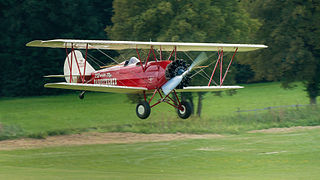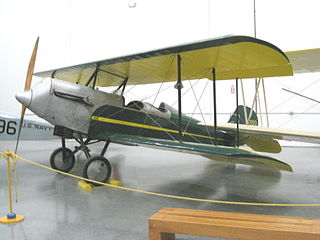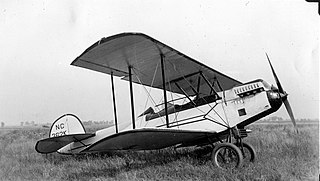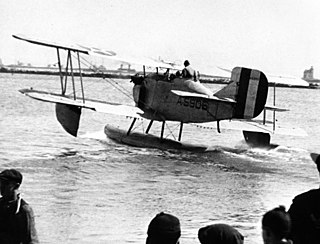Related Research Articles

The Travel Air 2000/3000/4000 (originally, the Model A, Model B and Model BH were open-cockpit biplane aircraft produced in the United States in the late 1920s by the Travel Air Manufacturing Company. During the period from 1924–1929, Travel Air produced more aircraft than any other American manufacturer, including over 1,000 biplanes. While an exact number is almost impossible to ascertain due to the number of conversions and rebuilds, some estimates for Travel Air as a whole range from 1,200 to nearly 2,000 aircraft.

The Reid Rambler, later known under the Curtiss-Reid brand after Reid was purchased by Curtiss, was a biplane trainer/sport aircraft built in Canada in the early 1930s and used in small numbers as a trainer aircraft by the Royal Canadian Air Force.

The Kreider-Reisner Challenger was an American utility biplane aircraft designed and produced by the Kreider-Reisner Aircraft Company, which was later taken over by the Fairchild Aircraft Company.

The International F-17 Sportsman was a 1920s American three-seat open-cockpit biplane designed and manufactured by the International Aircraft Corporation in Long Beach, California and Cincinnati, Ohio. 107 aircraft were built, 77 of them at Cincinnati.
The Thomas Brothers T-2 was an American-built biplane which served with the Royal Navy.

The Lincoln-Page PT was an American open-cockpit two-seat single-bay biplane trainer aircraft produced from 1929 to 1931.

The Swallow TP was a trainer aircraft produced by the Swallow Airplane Company in the United States from 1928.

The American A-1 and A-101 were American two and three-seat biplanes of the 1920s.

The American Eagle A-129 was a 1920s biplane built in the U.S.A.

The Waco 10/GXE/Waco O series was a range of three-seat open-cockpit biplanes built by the Advance Aircraft Company, later the Waco Aircraft Company.

The Swallow Airplane Swallow is an American-built general purpose biplane of the mid- to late 1920s.

The H-10 Pheasant was a tandem-seat conventional landing gear-equipped biplane with fabric covering, built in 1928 by the Pheasant Aircraft Company to compete in the crowded market of barnstorming biplanes. The company dissolved shortly after, during the Great Depression of the early 1930s.

The Pitcairn PA-3 Orowing is an early Pitcairn biplane designed for light commercial use in the early 1920s when aircraft production rates did not meet demand for airmail, training, and passenger aircraft.

The Curtiss Oriole was an American three-seat general-purpose biplane.

The Curtiss Model J was a prototype tractor configuration aircraft that became the basis for the Curtiss Jenny series of aircraft.

The Curtiss CA-1 was an American five-seat biplane amphibian designed by Frank Courtney and built by Curtiss-Wright at St Louis, Missouri.

The Parks P-1 was an American three-seat sport biplane that was built in the late 1920s.

The Curtiss Model 22 Cox Racers were two specialised racing aircraft built by the American Curtiss Aeroplane and Motor Company. The type was flown as a monoplane, biplane and triplane.

The Early Bird Jenny is an American homebuilt aircraft that was designed by Dennis Wiley and produced by the Early Bird Aircraft Company of Erie, Colorado, also by Leading Edge Airfoils of Peyton, Colorado. When it was available the aircraft was supplied as a kit and also in the form of plans for amateur construction.

G Elias & Brother was and American manufacturer of cabinets and aircraft based in Buffalo, New York in the 1920s. A.G. Elias sat on the Manufacturers Aircraft Association's board of directors along with President Frank H. Russell, VP Glenn L. Martin, Charles L. Laurence, Chance M. Vought, S.S. Bradley, George P. Tidmarsh, and Donald Douglas. E.J Elias promoted the construction of a Buffalo municipal airport to aid the local fledgling airplane industry of five aviation companies constructing airplanes and airplane parts. From 1920 to 1925, Elias company's chief engineer, David Earle Dunlap (1896-1957), designed the Elias EM-2 Expeditionary planes. He designed the NBS-3 bomber fuselage and the Elias M-1 Mail plane. Dunlap's Elias TA-1 design was the first United States Army Air Corps Trainer to have a radial engine. After tests a McCook Field, the Army Air Corps selected other manufacturers over the Elias bomber and trainer. The company designed the Elias EM-1 to meet requirements for a multirole amphibian marine expeditionary aircraft. Elias delivered six production Elias EM-2 aircraft with Liberty engines to the United States Navy in 1922.
References
Notes
Bibliography
- The Illustrated Encyclopedia of Aircraft (Part Work 1982-1985). Orbis Publishing.